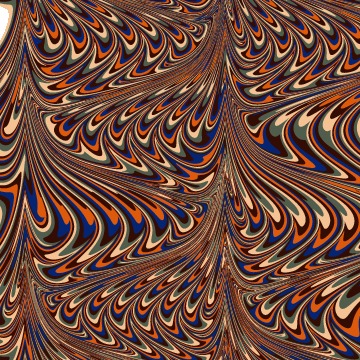

| http://people.csail.mit.edu/jaffer/Marbling/Scallops |
Scallop and Clam Shells |
One beautiful marbling pattern used for endpapers looks like an array of patterned scallop shells. With their sinews splitting and merging, it is difficult to see how such patterns are generated. Dan St. John of Chena River Marblers was kind enough to explain that this pattern is produced by sinusoidal motion of a comb having two sets of tines offset both in the direction and perpendicular to the direction of the stroke.
Splitting the offset comb into two parts and stroking each separately allows these patterns to be produced with the tools already developed.
In the progression below, the contents of the PostScript procedure Composite-map are displayed with the change from the previous contents in red. Composite-map takes an x and y coordinate pair on the stack and leaves the transformed x and y on the stack.
 Here are paint circles stroked upward with a fine-toothed comb.
Here are paint circles stroked upward with a fine-toothed comb.
 Make horizontal sinusoidal displacements like the
serpentine case.
Make horizontal sinusoidal displacements like the
serpentine case.
 Stroke two tines straight upward.
Stroke two tines straight upward.
 Subtract the sinusoidal displacement; now those last two strokes are
sinusoidal.
Subtract the sinusoidal displacement; now those last two strokes are
sinusoidal.
 Now apply the opposite horizontal sinusoidal displacement.
Now apply the opposite horizontal sinusoidal displacement.
One displacement of -90*sin replaces two displacements of -45*sin.
 Stroke three tines straight upward.
Stroke three tines straight upward.
The third tine is off-screen to the right.
 Finally, subtract the sinusoidal displacement.
Finally, subtract the sinusoidal displacement.
[image is linked to PostScript file]
 Reversing the direction of the initial combing results in a variant
looking more like giant clam shells.
Reversing the direction of the initial combing results in a variant
looking more like giant clam shells.
[image is linked to PostScript file]
 Reversing the direction of the final combing results in a variant like
a book cover I have seen.
Reversing the direction of the final combing results in a variant like
a book cover I have seen.
[image is linked to PostScript file]
 The dense crowding of contours in this pattern makes the sinusoidal
channels speckled when
raster-rendered.
The dense crowding of contours in this pattern makes the sinusoidal
channels speckled when
raster-rendered.
[image is linked to PostScript file]
 Oversampling by a factor of two in both directions reduces the
speckling significantly.
Oversampling by a factor of two in both directions reduces the
speckling significantly.
 Drawing the contours rather than filling them makes images resembling
topographic maps. This image is oversampled.
Drawing the contours rather than filling them makes images resembling
topographic maps. This image is oversampled.
 Looking at a print of the entire projection of the paint circles, Carl
Mikkelsen noticed that outlines of the top and bottom of the figure
are similar. This naturally leads to the next
chapter, which extends marbling to a two-dimensional manifold.
Looking at a print of the entire projection of the paint circles, Carl
Mikkelsen noticed that outlines of the top and bottom of the figure
are similar. This naturally leads to the next
chapter, which extends marbling to a two-dimensional manifold.
Copyright © 2004, 2007, 2010, 2016 Aubrey Jaffer
|
I am a guest and not a member of the MIT Computer Science and Artificial Intelligence Laboratory.
My actions and comments do not reflect in any way on MIT. | ||
| Topological Computer Graphics | ||
| agj @ alum.mit.edu | Go Figure! | |